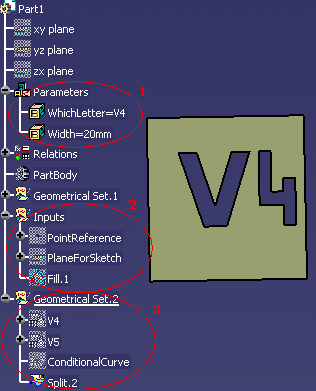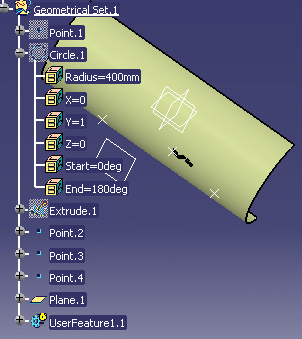 |
This model is made up of the following
items:
|
-
Open the PktMorphingUDF.CATPart file.
-
From the Start>Knowledgeware menu, access the Product Knowledge Template workbench.
-
Click the Create a UserFeature icon (
 )
to select the items that will make up the User Feature. The User Feature
Definition window is displayed.
)
to select the items that will make up the User Feature. The User Feature
Definition window is displayed. -
In the Definition tab, select:
- The formulas in the specification tree.
- The WhichLetter and the Width parameter
- The WhichLetterRule rule
- The Geometrical Set.2
-
In the Parameters tab, publish the following parameters. Click OK when done to close the User Feature Definition window.
- WhichLetter
- Width
-
Save your file and close it.
-
Open the PktDestinationPart.CATPart file. It contains a surface, different points, as well as a plane, that will be the inputs of the instantiated User Feature.
-
Click the Instantiate from Document icon (
 ),
select the file that you have saved in the File Selection window, and
click Open. The Insert Object dialog box is displayed. Make
the appropriate selection.
),
select the file that you have saved in the File Selection window, and
click Open. The Insert Object dialog box is displayed. Make
the appropriate selection.- Select Plane.1 in the geometry.
- Select Point.3 as a reference point.
- Select Extrude.1.
- Click OK when done. The User Feature is instantiated.

-
Expand the UserFeature1.1 node.
-
Double-click the WhichLetter parameter. In the Edit Parameter dialog box, change the parameter value to V5 and click OK. V5 now is displayed on the surface.
- Double-click the Width parameter. In the Edit Parameter dialog box, change the parameter value to 40mm and click OK. The size is modified accordingly.
-